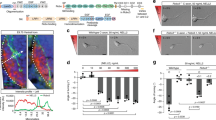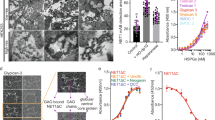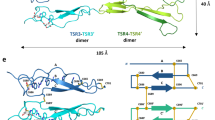Abstract
Slit proteins are a family of secreted guidance proteins that can repel neuronal migration and axon growth via interaction with their cellular roundabout receptors (Robos). Here it was shown that Slit2–Robo-1 interactions were enhanced by cell-surface heparan sulfate. Removal of heparan sulfate decreased the affinity of Slit for Robo by about threefold. In addition, removal of cell-surface heparan sulfate by heparinase III abolished the chemorepulsive response to Slit2 normally shown by both the migrating neurons and growing axons. These results indicate essential roles for cell-surface heparan sulfate in the repulsive activities of Slit2.
This is a preview of subscription content, access via your institution
Access options
Subscribe to this journal
Receive 12 print issues and online access
$209.00 per year
only $17.42 per issue
Buy this article
- Purchase on Springer Link
- Instant access to full article PDF
Prices may be subject to local taxes which are calculated during checkout






Similar content being viewed by others
References
Kennedy, T. E., Serafini, T., de la Torre, J. R. & Tessier-Lavigne, M. Netrins are diffusible chemotropic factors for commissural axons in the embryonic spinal cord. Cell 78, 425–435 (1994).
Serafini, T. et al. Netrin-1 is required for commissural axon guidance in the developing vertebrate nervous system. Cell 87, 1001–1014 (1996).
Serafini, T. et al. The netrins define a family of axon outgrowth-promoting proteins homologous to C. elegans UNC-6. Cell 78, 409–424 (1994).
Luo, Y., Raible, D. & Raper, J. A. Collapsin: a protein in brain that induces the collapse and paralysis of neuronal growth cones. Cell 75, 217–227 (1993).
Kolodkin, A. L., Matthes, D. J. & Goodman, C. S. The semaphorin genes encode a family of transmembrane and secreted growth cone guidance molecules. Cell 75, 1389–1399 (1993).
Brose, K. et al. Slit proteins bind Robo receptors and have an evolutionarily conserved role in repulsive axon guidance. Cell 96, 795–806 (1999).
Kidd, T., Bland, K. S. & Goodman, C. S. Slit is the midline repellent for the robo receptor in Drosophila. Cell 96, 785–794 (1999).
Li, H. S. et al. Vertebrate slit, a secreted ligand for the transmembrane protein roundabout, is a repellent for olfactory bulb axons. Cell 96, 807–818 (1999).
Ba-Charvet, K. T. N. et al. Slit2-mediated chemorepulsion and collapse of developing forebrain axons. Neuron 22, 463–473 (1999).
Rothberg, J. M., Jacobs, J. R., Goodman, C. S. & Artavanis-Tsakonas, S. Slit: an extracellular protein necessary for development of midline glia and commissural axon pathways contains both EGF and LRR domains. Genes Dev. 4, 2169–2187 (1990).
Kidd, T. et al. Roundabout controls axon crossing of the CNS midline and defines a novel subfamily of evolutionarily conserved guidance receptors. Cell 92, 205–215 (1998).
Zallen, J. A., Yi, B. A. & Bargmann, C. I. The conserved immunoglobulin superfamily member SAX-3/Robo directs multiple aspects of axon guidance in C. elegans. Cell 92, 217–227 (1998).
Rajagopalan, S., Nicolas, E., Vivancos, V., Berger, J. & Dickson, B. J. Crossing the midline: roles and regulation of Robo receptors. Neuron 28, 767–777 (2000).
Rajagopalan, S., Vivancos, V., Nicolas, E. & Dickson, B. J. Selecting a longitudinal pathway: Robo receptors specify the lateral position of axons in the Drosophila CNS. Cell 103, 1033–1045 (2000).
Simpson, J. H., Kidd, T., Bland, K. S. & Goodman, C. S. Short-range and long-range guidance by slit and its Robo receptors. Robo and Robo2 play distinct roles in midline guidance. Neuron 28, 753–766 (2000).
Simpson, J. H., Bland, K. S., Fetter, R. D. & Goodman, C. S. Short-range and long-range guidance by Slit and its Robo receptors: a combinatorial code of Robo receptors controls lateral position. Cell 103, 1019–1032 (2000).
Battye, R., Stevens, A. & Jacobs, J. R. Axon repulsion from the midline of the Drosophila CNS requires slit function. Development 126, 2475–2481 (1999).
Bashaw, G. J. & Goodman, C. S. Chimeric axon guidance receptors: the cytoplasmic domains of slit and netrin receptors specify attraction versus repulsion. Cell 97, 917–926 (1999).
Nakayama, M. et al. Identification of high-molecular-weight proteins with multiple EGF-like motifs by motif-trap screening. Genomics 51, 27–34 (1998).
Holmes, G. P. et al. Distinct but overlapping expression patterns of two vertebrate slit homologs implies functional roles in CNS development and organogenesis. Mech. Dev. 79, 57–72 (1998).
Itoh, A., Miyabayashi, T., Ohno, M. & Sakano, S. Cloning and expressions of three mammalian homologues of Drosophila slit suggest possible roles for Slit in the formation and maintenance of the nervous system. Brain Res. Mol. Brain Res. 62, 175–186 (1998).
Erskine, L. et al. Retinal ganglion cell axon guidance in the mouse optic chiasm: expression and function of Robos and Slits. J. Neurosci. 20, 4975–4982 (2000).
Ringstedt, T. et al. Slit inhibition of retinal axon growth and its role in retinal axon pathfinding and innervation patterns in the diencephalon. J. Neurosci. 20, 4983–4991 (2000).
Niclou, S. P., Jia, L. & Raper, J. A. Slit2 is a repellent for retinal ganglion cell axons. J. Neurosci. 20, 4962–4974 (2000).
Wang, K. H. et al. Biochemical purification of a mammalian slit protein as a positive regulator of sensory axon elongation and branching. Cell 96, 771–784 (1999).
Wu, W. et al. Directional guidance of neuronal migration in the olfactory system by the protein Slit. Nature 400, 331–336 (1999).
Zhu, Y., Li, H., Zhou, L., Wu, J. Y. & Rao, Y. Cellular and molecular guidance of GABAergic neuronal migration from an extracortical origin to the neocortex. Neuron 23, 473–485 (1999).
Hu, H. Chemorepulsion of neuronal migration by Slit2 in the developing mammalian forebrain. Neuron 23, 703–711 (1999).
Chen, J. H., Wen, L., Dupuis, S., Wu, J. Y. & Rao, Y. The N-terminal leucine-rich regions in Slit are sufficient to repel olfactory bulb axons and subventricular zone neurons. J. Neurosci. 21, 1548–1556 (2001).
Liang, Y. et al. Mammalian homologues of the Drosophila slit protein are ligands of the heparan sulfate proteoglycan glypican-1 in brain. J. Biol. Chem. 274, 17885–17892 (1999).
Nugent, M. A. & Edelman, E. R. Kinetics of basic fibroblast growth factor binding to its receptor and heparan sulfate proteoglycan: a mechanism for cooperactivity. Biochemistry 31, 8876–8883 (1992).
Hu, H. & Rutishauser, U. A septum-derived chemorepulsive factor for migrating olfactory interneuron precursors. Neuron 16, 933–940 (1996).
Pini, A. Chemorepulsion of axons in the developing mammalian central nervous system. Science 261, 95–98 (1993).
Bernfield, M. et al. Functions of cell surface heparan sulfate proteoglycans. Annu. Rev. Biochem. 68, 729–777 (1999).
Binari, R. C. et al. Genetic evidence that heparin-like glycosaminoglycans are involved in wingless signaling. Development 124, 2623–2632 (1997).
Lin, X., Buff, E. M., Perrimon, N. & Michelson, A. M. Heparan sulfate proteoglycans are essential for FGF receptor signaling during Drosophila embryonic development. Development 126, 3715–3723 (1999).
Lin, X. & Perrimon, N. Dally cooperates with Drosophila Frizzled 2 to transduce Wingless signalling. Nature 400, 281–284 (1999).
Hacker, U., Lin, X. & Perrimon, N. The Drosophila sugarless gene modulates Wingless signaling and encodes an enzyme involved in polysaccharide biosynthesis. Development 124, 3565–3573 (1997).
Haerry, T. E., Heslip, T. R., Marsh, J. L. & O'Connor, M. B. Defects in glucuronate biosynthesis disrupt Wingless signaling in Drosophila. Development 124, 3055–3064 (1997).
The, I., Bellaiche, Y. & Perrimon, N. Hedgehog movement is regulated through tout velu-dependent synthesis of a heparan sulfate proteoglycan. Mol. Cell 4, 633–639 (1999).
Bellaiche, Y., The, I. & Perrimon, N. Tout-velu is a Drosophila homologue of the putative tumour suppressor EXT-1 and is needed for Hh diffusion. Nature 394, 85–88 (1998).
Bullock, S. L., Fletcher, J. M., Beddington, R. S. & Wilson, V. A. Renal agenesis in mice homozygous for a gene trap mutation in the gene encoding heparan sulfate 2-sulfotransferase. Genes Dev. 12, 1894–1906 (1998).
Kinnunen, T. et al. Neurite outgrowth in brain neurons induced by heparin-binding growth-associated molecule (HB-GAM) depends on the specific interaction of HB-GAM with heparan sulfate at the cell surface. J. Biol. Chem. 271, 2243–2248 (1996).
Kinnunen, A. et al. Heparan sulphate and HB-GAM (heparin-binding growth-associated molecule) in the development of the thalamocortical pathway of rat brain. Eur. J. Neurosci. 11, 491–502 (1999).
Kinnunen, A. et al. N-syndecan and HB-GAM (heparin-binding growth-associated molecule) associate with early axonal tracts in the rat brain. Eur. J. Neurosci. 10, 635–648 (1998).
Karthikeyan, L. et al. Immunocytochemical and in situ hybridization studies of the heparan sulfate proteoglycan, glypican, in nervous tissue. J. Cell Sci. 107, 3213–3222 (1994).
Saunders, S., Paine-Saunders, S. & Lander, A. D. Expression of the cell surface proteoglycan glypican-5 is developmentally regulated in kidney, limb, and brain. Dev. Biol. 190, 78–93 (1997).
Litwack, E. D. et al. Expression of the heparan sulfate proteoglycan glypican-1 in the developing rodent. Dev. Dyn. 211, 72–87 (1998).
Yayon, A., Klagsbrun, M., Esko, J. D., Leder, P. & Ornitz, D. M. Cell surface, heparin-like molecules are required for binding of basic fibroblast growth factor to its high affinity receptor. Cell 64, 841–848 (1991).
Rapraeger, A. C., Krufka, A. & Olwin, B. B. Requirement of heparan sulfate for bFGF-mediated fibroblast growth and myoblast differentiation. Science 252, 1705–1708 (1991).
Acknowledgements
Thanks to J. Y. Wu and Y. Rao for rat Robo-1 expression plasmid, M. Tessier-Lavigne for Slit2 expression plasmid, V. Lemmon for anti-L1 antibody, V. Lemmon, B. Wible and B. Wang for discussions during this project, D. Kunze and V. Lemmon for reading the manuscript and M. Pendergast for help with the confocal microscope. Supported by the National Institutes of Health grant NS38877.
Author information
Authors and Affiliations
Corresponding author
Rights and permissions
About this article
Cite this article
Hu, H. Cell-surface heparan sulfate is involved in the repulsive guidance activities of Slit2 protein. Nat Neurosci 4, 695–701 (2001). https://doi.org/10.1038/89482
Received:
Accepted:
Issue Date:
DOI: https://doi.org/10.1038/89482
This article is cited by
-
NELL2-Robo3 complex structure reveals mechanisms of receptor activation for axon guidance
Nature Communications (2020)
-
Pax6 modulates intra-retinal axon guidance and fasciculation of retinal ganglion cells during retinogenesis
Scientific Reports (2020)
-
A Traveling Wave Ion Mobility Spectrometry (TWIMS) Study of the Robo1-Heparan Sulfate Interaction
Journal of the American Society for Mass Spectrometry (2018)
-
Slit2/Robo1 Mediation of Synaptic Plasticity Contributes to Bone Cancer Pain
Molecular Neurobiology (2017)
-
The role of heparan sulfate deficiency in autistic phenotype: potential involvement of Slit/Robo/srGAPs-mediated dendritic spine formation
Neural Development (2016)



